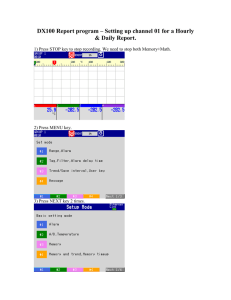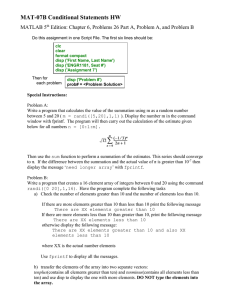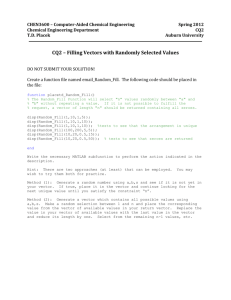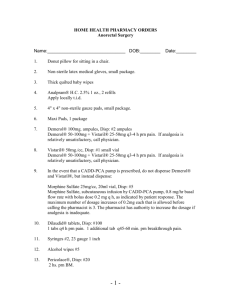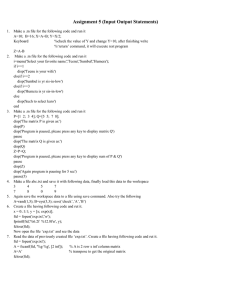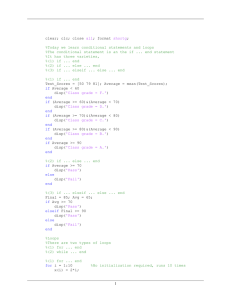Appendix A: Rotating (DQ)
advertisement
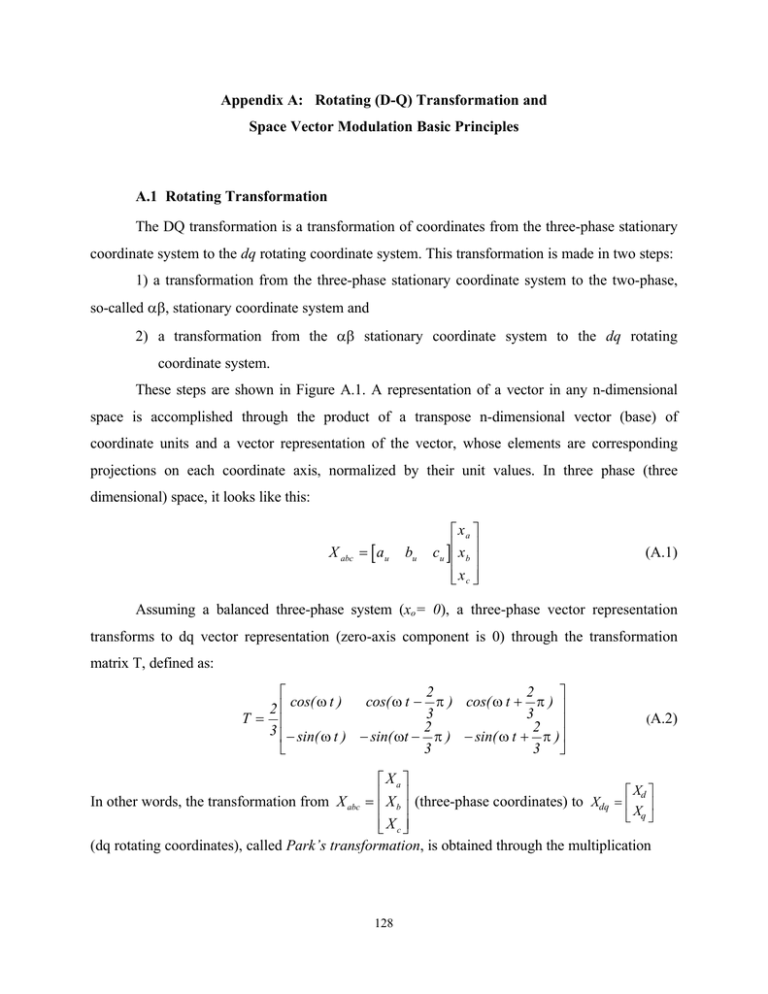
Appendix A: Rotating (D-Q) Transformation and
Space Vector Modulation Basic Principles
A.1 Rotating Transformation
The DQ transformation is a transformation of coordinates from the three-phase stationary
coordinate system to the dq rotating coordinate system. This transformation is made in two steps:
1) a transformation from the three-phase stationary coordinate system to the two-phase,
so-called αβ, stationary coordinate system and
2) a transformation from the αβ stationary coordinate system to the dq rotating
coordinate system.
These steps are shown in Figure A.1. A representation of a vector in any n-dimensional
space is accomplished through the product of a transpose n-dimensional vector (base) of
coordinate units and a vector representation of the vector, whose elements are corresponding
projections on each coordinate axis, normalized by their unit values. In three phase (three
dimensional) space, it looks like this:
X abc = [ a u
bu
xa
cu ] x b
x c
(A.1)
Assuming a balanced three-phase system (xo= 0), a three-phase vector representation
transforms to dq vector representation (zero-axis component is 0) through the transformation
matrix T, defined as:
2
2
cos(
ω
t
)
cos(
ω
t
−
π
)
cos(
ω
t
+
π)
2
3
3
T=
3 − sin( ω t ) − sin( ωt − 2 π ) − sin( ω t + 2 π )
3
3
(A.2)
Xa
Xd
In other words, the transformation from X abc = X b (three-phase coordinates) to Xdq =
Xq
X c
(dq rotating coordinates), called Park’s transformation, is obtained through the multiplication
128
β
β
b
d
βu
bu
q
π
3
π
3
θ = ωt
π
6
ο
αu
ο
a ≡α
au
α
π
6
cu
c
[α
u
βu
οu ] = [a u
cu ]
bu
[d
u
qu
1
2 1
−
3 2
1
−
2
0
3
2
3
−
2
ou ] = [a u
bu
1
2
1
2
1
2
cu ]
[d
u
qu
ou ] = [αυ
βυ
cosθ
ου ] sin θ
0
− sin θ 0
cosθ 0
0
1
1
cosθ
− sin θ
2
2π
2π
1
2
cos( θ −
) − sin( θ −
)
3
3
3
2
cos( θ + 2π ) − sin( θ + 2π ) 1
3
3
2
Figure A.1 Park’s transformation from three-phase to rotating dq0 coordinate system
129
of the vector Xabc by the matrix T:
X dq = TX abc
(A.3)
The inverse transformation matrix (from dq to abc) is defined as:
− sin( ω t )
cos( ω t )
2
2
T ' = cos( ω t − 3 π ) − sin( ω t − 3 π )
2
2
cos(
ω
t
+
π
)
−
sin(
ω
t
+
π)
3
3
(A.4)
The inverse transformation is calculated as:
X abc = T ' X dq
(A.5)
A.2 Space Vector Modulation Basic Principles
The space vector modulation (SVM) basic principles are shown in Figure A.2. A classical
sinusoidal modulation limits the phase duty cycle signal to the inner circle. The space vector
modulation schemes extend this limit to the hexagon by injecting the signal third harmonic. The
result is about 10% (2/1.73 x 100%) higher phase voltage signal at the inverter output. The PWM
modulation chops alternatively two adjacent phase voltage and zero voltage signals in a certain
pattern producing the switching impulses for the inverter Sa, Sb and Sc. Various SVM modulation
schemes have been proposed in literature [72-78] and some recent analyzes show that there is a
trade-off between the switching loses and the harmonic content, so-called THD, produced by the
SVM modulation [25].
130
b
1
β
dβ dc
ds
phase duty cycle limit
line duty cycle limit
Sa
da
dα
1
a, α
Sc
clock
c
Figure A.2 Space Vector Modulation Basic Principles
131
Sb
Appendix B: Derivation of the Flux-Weakening Equations
B.1 Constant Voltage Constant Power Control
This flux-weakening control method is based on two constraints - constant power and
constant phase voltage vector, Eq.s (B.1) - implemented in the PMSM drive d-q model in Eq.s
(12) to define the id and iq current reference algorithms, Eq.s (B.2). For the sake of simplicity, the
id current base value is set to be zero.
vd = Vdb
vq = Vqb
P = v d id + v q iq = Vqb I qb
Rid − pLq ωiq = − pLq ωI qb ⇒ iq ≈ I qb
Riq pLd ωid + k t ω = RI qb + k t Ω b
(B.1)
Ωb
k Ω
ω ⇒ id = − t 1 − b
pLd
ω
(B.2)
The linear relationship between id and iq comes from Eq.s (B.2):
pL
iq = I qb 1 + d
kt
(B.3)
The critical speed, ωcr, is derived from the VSI maximum current limit, Is, supposed to be
maintained before entering the flux-weakening region, Eq. (B.4) and reached again at ω = ωcr.
id2 + iq2 = I s = I qb
(B.4)
Substituting id and iq in Eq. (B.4) with the expressions from Eq.s (B.3), and solving for ω, the
solution for ωcr becomes Eq. (B.5).
ω cr =
Vqb2 + Vdb2
Vqb2 − Vdb2
Ωb
(B.5)
Applying the PMSM dq model Eq.s (12), in Eq. (B.1), the Eq. (B.6) is derived:
Rid2 + Riq2 − pLqωiq id + pLd ωid iq + k t ωiq = RI qb2 + k t Ωb I qb
(B.6)
The constant power is maintained only under the assumption from Eq. (B.7) and negligible
voltage drops across inductances Ld and Lq.
(
)
Rid2 + Riq2 − RI qb2 ≈ p Lq − Ld ωid iq
132
(B.7)
B.2 Constant Current Constant Power Control
Besides the constant power, this strategy tries to maintain a constant magnitude of the
phase current vector, as defined in Eq.s (B.9).
id2 + iq2 = I db2 + I qb2 = I qb
(B.9)
P = vd id + vq iq = Vqb I qb
Substituting the voltages vd and vq in the power equation by there expressions from the PMSM
drive d-q model, Eq. (B.10), and solving the Eq.s (B.9) for currents id and iq determines the d-q
current references, Eq.s (B.11).
Rid2 − pLq ω iq id + Riq2 + pLd ω id iq + k t ω iq = RI qb2 + k t Ωb I qb
Ω
Ω
iq ≈ I qb b ; id ≈ − I qb 1 − b
ω
ω
(
(B.10)
2
(B.11)
)
The assumption that k t >> p Ld − Lq id through the entire flux-weakening region is made for the
sake of simplicity and is a reasonable assumption. By neglecting the voltage drop across the stator
resistance R (which is negligible at high speeds) and substituting iq and id from Eq. (B.11) into the
PMSM model Eq.s (12), we can get the vd and vq voltage trajectories:
vd = Vdb = − pLq I qb Ω b
2
ω
ω
L
vq = Vqb
+ d Vd
−1
Ω b Lq
Ω b
(B.12)
The critical speed, ωcr, can be obtained by equalizing the vq voltage with its base value Vqb.
The result is the same as the one obtained for the constant voltage, shown in Eq. (B.5). The
prevailing speed at which the vq voltage reaches its minimum, see Figure 29, is calculated from
Eq.s (B.12):
dv q
dω
=
Vqb
Ωb
Vd'
+
Ωb
Ω2
1 − 2b
ω
133
= 0 ⇒ ωp =
Ωb
V
1 − −
Vqb
'
d
2
(B.13)
B.3 Optimum Current Vector Control
In contrast to constant power flux-weakening strategies, this strategy leaves the active
power to change with the change of the power factor, while maintaining both maximum current
and maximum voltage, Eq.s (B.14). In other words, it uses the maximum accessible power.
i d2 + iq2 = I db2 + I qb2 = I qb
(B.14)
vd2 + vq2 = Vdb2 + Vqb2 = Vs
Developing the voltage constraint from the voltage equations in Eq.s (12), we are getting
Eq. (B.15).
( Ri
d
− pLqω iq
) + ( Ri
2
q
+ pLd ω id + k t ω
) = (− pL Ω I ) + ( RI
2
2
q
b qb
qb
+ k t Ωb
)
2
(B.15)
After solving (B.14) for iq and substituting in (B.15), we are getting the quadratic Eq. (B.16) on
the variable id.
Aid2 + Bi d + C = 0
(B.16)
where
( )
A = ( pLd ) − pLq
2
2
(
; B = 2 pLd k t ; C = pLq I qb
)
2
Ω2
+ k t 2 1 − 2b
ω
(B.17)
and which solution for id<0 is:
(
L2d − L2q
kt
L
id < 0 ⇒ i d = −
1− 1−
pLd L2d − L2q
L2d
2
d
) ( pL I )
q qb
kt 2
2
2
Ω b
+ 1 1 − 2
ω
(B.18)
In the case of non-salient PMSM, the solution is more trivial, since A=0:
C
id = − = −
B
(
pL I
q qb
)
Ω2
+ k t 2 1 − 2b
ω
2 pLd k t
2
(B.19)
The Eq. (B.18) can be expressed as
Ωb2
id = I p 1 − 1 + K 1 − 2
ω
where
134
(B.20)
Leq =
L2q − L2d
Ld
Leq I qb2 L2q
kt
2 2 + 1
; Ip =
; K=
pLeq
Ld I p Leq
(B.21)
Finally, by solving for iq from Eq.s (B.20) and (B.14) we are getting the iq current algorithm for
the OCV flux-weakening control, Eq. (B.22).
i q = I qb
Ip
1 −
I qb
2
Ω2
1 − 1 + K 1 − b2
ω
2
(B.22)
The vd and vq trajectories are obtained by substituting id and iq current in voltage Eq.s (12)
by Eq.s (B.20) and (B.22).
2
vd ≈ − pLq iq ω = − pLq I qb
[
Ip
ω − ω − ω 2 + K (ω 2 − Ω b2 )
I qb
2
[
]
vq ≈ pLd id ω + ktω = pLd I p ω − ω 2 + K(ω 2 − Ω b2 ) + kt ω
]
2
(B.23)
(B.24)
The speed where the voltage component vq reaches its minimum from Figure 30, can be
obtained from the first derivative of vq over speed ω in Eq. (B.24).
(1 + K )ω
+k =0
= pLd I p 1 −
t
2
2
2
dt
ω
+
ω
−
K
Ω
(
)
b
dvq
(1 + K )ω
ω 2 + K (ω 2 − Ωb2 )
= 1+
2
q
2
d
L
kt
=
⇒ ω = Ωb
pLd I p L
K
(1 + K )
2 ⇒ v q = v q min
L2d
1 − (1 + K ) 2
Lq
(B.25)
135
Appendix C: Program Listings for the PMSM Drive
Small and Large Signal Analyses
As an example, here is given a listing of the Matlab code for the Bode analysis and control
design of the PMSM drive system (modified for the two-column editorial purposes). The output
file, called display, is given on the last page. The system model is developed and stored in the
Simulink file vpbode11.m. Because of the model complexity, only the highest hierarchical level is
given in Figure C.1. However, this model, as well as the time-domain simulation Matlab models
and the equivalent Saber model library, are available at Virginia Power Electronics Center
(VPEC) at Virginia Tech.
% File K1_bode.m
R=0.08
%
disp 'Stator inductance in parallel op. mode [H]:'
% MATLAB PROGRAM FOR BODE ANALYSIS OF
L=0.19e-3
THE CONTROL OF DQ MODELS OF PERMANENT
disp 'Stator ind. in parallel op. mode in q-axis in [H]:'
MAGNET SYNCHRONOUS MOTORS (PMSM)
Lq=0.8*L
disp 'Stator ind. in parallel op. mode in d-axis in [H]:'
% Created by Zoran Mihailovic at VPEC, Virginia
Ld=0.4*L
Tech, 1996
disp 'Torque constant in parallel op. mode [Nm/A]:'
kt=0.19
clear;
disp 'Number of pairs of poles:'
x=[];u=[];y=[];
p=3
delete diary;
disp 'Moment of inertia of the rotor [kgm^2]:'
diary on
Jm=0.0017
% ~~~~~~~~~~~~~~~~~~~~~~~~~~~~
disp 'Maximum speed (in parallel mode) [rad/s]:'
disp ' '
Wmax=14650/9.55
disp 'PARAMETERS OF THE SYSTEM:'
disp 'Series to parallel switch threshold const. [rpm]:'
disp '~~~~~~~~~~~~~~~~~~~~~~~~~'
st1=5500
disp '_s - series mode; _p - parallel mode'
disp 'Motor shut down [rpm]:'
disp ' '
st2=11500
disp ' Motor_d-q_model:'
st=st1;
disp '~~~~~~~~~~~~~~~~~'
disp ' '
disp ' '
disp 'Stator resistance in parallel op. mode [Ohm]:'
136
disp 'Motor Periferies:'
Tfr_dc=1.9;
disp '~~~~~~~~~~~~~~~~~'
Bl_dc=0.568*9.55/1000; % viscous damping
disp 'SVM modulation coefficient:'
J_dc=0.064;
Fm=1/sqrt(3)
Rext=10;
disp 'Inverter switching frequency [Hz]:'
Wmax_dc=2250/9.55;
fs=44000
a given DC motor load
disp 'Filter inductance per phase [H]:'
% Maximum torque with the stator closed by Rext:
Lf=0.34e-3;
B1=kt_dc*kb_dc; % torque constant [Nm/(rad/s)]
disp 'DC link voltage [V]:'
%B1=0;
Vdc=370
Temax_dc=B1/Rext*Wmax_dc;
%Lq=L; Ld=L; Lf=0; % d and q axis ind. for a non-
% Total load on the PMSM shaft:
salient PMSM without external filter inductance
J=(J+J_dc);
% inertia on the rotor shaft
disp ' '
Tfr=1;
% static friction
disp 'Limiters:'
Blt=Bl_dc;
% viscous damping
disp '~~~~~~~~~'
kl=Blt+B1/Rext; % total damping [Nm/(rad/s)]
disp ' '
Wdcmax=2500/9.55; % maximum speed [rad/s] of
disp 'Maximum phase voltage [V]'
the DC motor
Vs=Vdc*Fm
% ****************************************
disp 'Maximum phase current [A]:'
disp ' '
Is=50
disp 'Torque resistance, kl is given as a load torque
disp 'Current scaling factor (normalization) [1/A]:'
vs. speed look-up table.'
Kim=1/Is
disp 'Load inertia [kgm2]:'
disp 'Speed scaling factor (normalization) [1/(rad/s)]
J_load=0.316
Kwm=1/(Wmax)
disp 'Total inertia on the rotor shaft [kgm2]:'
% ~~~~~~~~~~~~~~~~~~~~~~~~~~~~
J=Jm+J_load
% LOAD:
disp ' '
% ~~~~~
disp 'Sampling and zero-order hold delays:'
% ***************************************
disp '~~~~~~~~~~~~~~~~~~~~~~~~~~~~~~~~~~'
% Examples:
disp 'Sampling delay [s]:'
% 1) Specified load by look-up table model or
T=1.5/fs;
% 2) DC motor (VPEC's testing load):
T=20e-6
Ra=0.045;
disp 'Zero-order hold delay [s]:'
La=0.33*1e-3;
% resistance of the dc motor windings
% dc motor windings inductance
kt_dc=0.56*1.11;
% static friction
% rotor inertia
% external stator resistance
% max. speed [rad/s] with
% open stator windings
Tz=1.5/fs
% torque sensitivity
Ti=20e-6; % sampling delay in current loops [s]
% ~~~~~~~~~~~~~~~~~~~~~~~~~~~~
kb_dc=0.59*0.955*1.11; % voltage sensitivity (if not
saturated kb_dc=kt_dc)
137
disp 'CONTROL'
wc=2*pi*fc
disp '~~~~~~~'
frequency) [rad/s]
disp ' '
disp 'Desired phase margin [deg.]:'
disp 'Operating point [rad/s]:'
phm_deg=45
% in degrees
disp '~~~~~~~~~~~~~~~~~~~~~~~~'
phm=phm_deg*pi/180;
% in radians
wop=5000*pi/30 % operating point w[rad/s]
disp 'Desired gain margin:'
disp ' '
Gm=0.5
% in absolute units
disp 'Current controllers & decoupling:'
Gm_dB=20*log10(Gm)
% in dB
disp '~~~~~~~~~~~~~~~~~~~~~~~~~~~~~~~~~'
disp 'Gains of current loop PI controllers:'
disp ' '
Kp=wc*L/(Vs*Kim); % init. guess for proportional
% Sampling delay, T(s)=exp(-sTi) causes phase drop
gain of the PI_s regulator (without filter Lf=0)
of approximately 360deg. at frequency 3/Ti, so the
Ki=Kp*R/L; % initial guess for integral gain of the
maximum bandwidth (for about 45deg. phase drop
PI_s regulator (without filter - Lf=0)
caused by the delay) is about 1/(3*Ti). Also, to avoid
disp 'Parallel operating mode:'
the influence of the switching, the cross-over frequency
Kpq_p=Kp*(Lq+Lf)/L
should be smaller than fs/5.
PI_p regulator in q-axis
% To avoid combined influence of above mentioned,
Kpd_p=Kp*(Ld+Lf)/L
choose the cross-over frequency, fc, smaller or equal to
PI_p regulator in d-axis
min(fs/10,1/(5*Ti)).
Kiq_p=Kpq_p*R/(Lq+Lf) % integral gain of the PI_p
disp 'Open current loop cross-over frequencies [rad/s]
regulator in q-axis
for ideally decoupled system:'
Kid_p=Kpd_p*R/(Ld+Lf) % integral gain of the PI_p
disp 'Parallel operating mode:'
regulator in d-axis
wcod_p=sqrt((Vs*Kim)^2-R^2)/(Ld+Lf)
% open d-
desired
bandwidth
(cross-over
% proportional gain of the
% proportional gain of the
disp 'Series operating mode:'
axis loop cross-over frequency
wcoq_p=sqrt((Vs*Kim)^2-R^2)/(Lq+Lf)
%
Kpq_s=Kp*(4*Lq+Lf)/L % proportional gain of the
% open q-
PI_s regulator in q-axis
axis loop cross-over frequency
Kpd_s=Kp*(4*Ld+Lf)/L % proportional gain of the
disp 'Series operating mode:'
PI_s regulator in d-axis
wcod_s=sqrt((Vs*Kim)^2-(4*R)^2)/(4*Ld+Lf)
Kiq_s=Kpq_s*4*R/(4*Lq+Lf)
% open d-axis loop cross-over frequency
the PI_s regulator in q-axis
wcoq_s=sqrt((Vs*Kim)^2-(4*R)^2)/(4*Lq+Lf)
Kid_s=Kpd_s*4*R/(4*Ld+Lf)
% open q-axis loop cross-over frequency
the PI_s regulator in d-axis
% Desired cross-over frequency:
% Series and parallel mode rated speed values (flux-
disp 'Current loop (desired) cross-over freq. [rad/s]:'
weakening base speed values):
fc=min(fs/10,1/(5*Ti)); % desired bandwidth (cross-
% ~~~~~~~~~~~~~~~~~~~~~~~~~~~~~~~~~~~~~
over frequency) [Hz]
disp 'Series mode rated speed [rpm]:'
138
% integral gain of
% integral gain of
wb_s=(-4*R*Is*2*kt+sqrt((4*R*Is*2*kt)^2+(Vs^2-
Kpw_s=Kiw_s/wz;
(4*R*Is)^2)*(4*kt^2+...
if abs(wp1)-wp2/20<=0
((Lf+4*Lq)*Is)^2)))/(4*kt^2+((Lf+Lq*4)*Is)^2)*9.55
wcs=wc/10;
% rated speed [rpm]
Kpw_s=J*wcs/Cw;
disp 'Parallel mode rated speed [rpm]:'
Kiw_s=Kpw_s*abs(wp1);
wb_p=(-R*Is*kt+sqrt((R*Is*kt)^2+(Vs^2-
end
(R*Is)^2)*(kt^2+((Lf+Lq)*Is)^2)))/...
disp 'Speed loop PI compensator gains for the series
(kt^2+((Lf+Lq)*Is)^2)*9.55 % rated speed [rpm]
mode:'
disp 'wait'
Kpw_s
% Speed Loop Controller (symmetrical optimum):
Kiw_s
% ~~~~~~~~~~~~~~~~~~~~~~~~~~~~~~~~~~~~~
% Parallel mode:
% Evaluation of the load torque profile
Cw=3/2*kt*Kwm;
x0=zeros*[];
wp2=Kiq_p*Vs*Kim/R;
options(1)=1e-3; % relative error (default 1e-3).
Gw=(wp1+wp2)^3/(8*abs(wp1)*wp2);
options(2)=1e-4; % min. step size (def. tend/2000).
wz=Gw*2*abs(wp1)*wp2/(wp1^2+wp2^2);
options(3)=1;
Kiw_p=abs(kl1)/Cw*Gw;
% max. step size (default tend/50).
tend=1600;
Kpw_p=Kiw_p/wz;
[t,x,y]=gear('loadvp',tend,x0,options);
if abs(wp1)-wp2/20<=0
load load.mat;
wcs=wc/10;
[kl,w1,Tl1] = kload(y); % calling Matlab file kload.m
Kpw_p=J*wcs/Cw;
for evaluation of the load resist. (load torque slope)
Kiw_p=Kpw_s*abs(wp1);
w=wop;
end
for i=1:size(w1)-1
disp 'Speed loop PI regul. gains for the parallel mode:'
if ((w1(i,1)<=w) & (w1(i+1,1)>w))
Kpw_p
kl1=kl(i)
Kiw_p
Tlop=Tl1(i)
% Without back emf elimin. (equivalent DC motor):
end
% ~~~~~~~~~~~~~~~~~~~~~~~~~~~~~~~~~~~~~
end
% Parallel mode:
kl1=1e-8;
Leq_p=Lq+Lf;
wp1=kl1/J
wel_p=R/Leq_p;
% Series mode:
C_p=1.5*kt^2/(Leq_p*J);
Cw=3/2*(2*kt)*Kwm;
A_p=0.5*(wel_p+wp1);
wp2=Kiq_s*Vs*Kim/(4*R);
B_p=sqrt(1-4*(wel_p*wp1+C_p)/(wel_p+wp1)^2);
Gw=(wp1+wp2)^3/(8*abs(wp1)*wp2);
sp1_p=A_p*(1-B_p); sp2_p=A_p*(1+B_p);
wz=Gw*2*abs(wp1)*wp2/(wp1^2+wp2^2);
Kpq_pdc=abs(Leq_p*sqrt(wc^2+sp2_p^2)/(Vs*Kim);
Kiw_s=Gw*abs(kl1)/(2*Cw);
Kiq_pdc=abs(Kpq_p*sp1_p);
139
% Series mode:
Iqref=Is;
Leq_s=4*Lq+Lf;
Tmref=1.5*(2*kt*Iqref+p*4*(Ld-Lq)*Idref*Iqref);
wel_s=4*R/Leq_s;
elseif w<st1/9.55
C_s=1.5*4*kt^2/(Leq_s*J);
Idref=(Is^2+Ip_s^2)/(2*Ip_s)*((wb_s/9.55/w)^2-1);
A_s=0.5*(wel_s+wp1);
Iqref=sqrt(Is^2-Idref^2);
B_s=sqrt(1-4*(wel_s*wp1+C_s)/(wel_s+wp1)^2);
Tmref=1.5*(2*kt*Iqref+p*(Ld-Lq)*Idref*Iqref);
sp1_s=A_s*(1-B_s); sp2_s=A_s*(1+B_s);
elseif w<=wb_p/9.55
Kpq_sdc=abs(Leq_s*sqrt(wc^2+sp2_s^2)/(Vs*Kim));
Idref=0; Iqref=Is;
Kiq_sdc=abs(Kpq_s*sp1_s);
Tmref=1.5*(kt*Iqref+p*(Ld-Lq)*Idref*Iqref);
Kpq_p=Kpq_pdc;
elseif w<=st2
Kiq_p=Kiq_pdc;
Idref=(Is^2+Ip_p^2)/(2*Ip_p)*((wb_p/9.55/w)^2-1);
Kpq_s=Kpq_sdc;
Iqref=sqrt(Is^2-Idref^2);
Kiq_s=Kiq_sdc;
Tmref=1.5*(kt*Iqref+p*(Ld-Lq)*Idref*Iqref);
% Closed/open loop switches:
else
% ~~~~~~~~~~~~~~~~~~~~~~~~~
Idref=0; Iqref=0; Tmref=0;
c1=-1; % command to open(1)/close(-1) current loops
end
c2=-1; % command to open(1)/close(-1) speed loop
Tlref=Tmref-Tlop;
c3=-1; % command to open(1)/close(-1) decoup. loops
% Determining the oper. point state space variables:
c4=-1; % command to open(-1)/close(1) anti-windup
disp 'If you get warning messages: "Divide by zero."
% ~~~~~~~~~~~~~~~~~~~~~~~~~~~~
or "Matrix is close to singular or badly scaled." or you
%
ESTIMATION
OF
THE
STEADY
STATE
want to speed up convergence process, move slightly
VALUES AND LINEARIZATION OF THE SYSTEM
your initial guess vector around the operating point
AT A CHOSEN OPERATING POINT
inside the trim command.'
% ~~~~~~~~~~~~~~~~~~~~~~~~~~~~~~~~~~~~~
disp 'To continue press any key.'
% Descriptions of the 'trim' and 'linmod' commands
pause
can be obtained by typing 'help trim' and 'help linmod'
w=wop+1; % moving the initial guess around the
commands in the matlab workspace
desired operating point
% ALWAYS CHOOSE INITIAL GUESS VALUES
disp ' '
SOMETHING HIGHER THAN EXPECTED VALUES
disp 'Steady state values at given operating point:'
IN STEADY STATE; TAKE CARE ABOUT DUTY
vpbode11; % calling SIMULINK MODEL stored in
CYCLE SATURATION!
file vpbode11.m
% Initial guess for the op. point (steady state) values:
%Idref=0;
Ip_s=kt/(p*(Lq+Lf));
wmin=0; wmax=2;
Ip_p=2*kt/(p*(4*Lq+Lf));
[x,u,y,dx]=trim('vpbode11',[0;w;0;Iqref;Idref;0;0;0;0;
if w<=wb_s/9.55
0;0;0;0;0],[Idref;Iqref;Tlref;w],[Idref;Iqref;0;0;Idref;I
Idref=0;
qref;w;Tmref;w;Iqref;0],[],[1;2;4],[])
140
disp ' '
c1=-1;c2=1;c3=-1; % switch commands for closed
disp 'Locations of state space variables on the simulink
current loop analysis
block diagram vpbode11:'
[A2,B2,C2,D2]=linmod('vpbode11',x,u);
x0=x;
%linearization of the system at the operating point
[sizes,x0,xstr]=vpbode11
for i=1:n
% Idm=Idref; Iqm=Iqref; Id=Idref; Iq=Iqref;
[ng1,dg1]=ss2tf(A2,B2,C2(i,:),D2(i,:),1);
% CLOSED SPEED LOOP TRANSFER FUNCTIONS
nng1(i,1:length(ng1))=ng1;
% ************************************
ddg1(i,1:length(dg1))=dg1;
c1=-1;c2=-1;c3=-1; % commands for closed speed loop
[ng2,dg2]=ss2tf(A2,B2,C2(i,:),D2(i,:),2);
[A1,B1,C1,D1]=linmod('vpbode11',x,u);
nng2(i,1:length(ng2))=ng2;
% linearization of the system at the operating point
ddg2(i,1:length(dg2))=dg2;
% Outputs:
[ng3,dg3]=ss2tf(A2,B2,C2(i,:),D2(i,:),3);
% 1 - id current (sampled)
nng3(i,1:length(ng3))=ng3;
% 7 - motor speed [rad/s]
ddg3(i,1:length(dg3))=dg3;
% 2 - iq current (sampled)
end
% 8 - motor torque [Nm]
% OPEN CURRENT LOOP TRANS. FUNCTIONS
% 3 - duty cycle command in d-axis, d_d
% ************************************
% 9 - reference speed [rad/s]
% a) with decoupling:
% 4 - duty cycle command in q-axis, d_q
c1=1; c2=1; c3=-1; % open current loop commands
% 10 - reference iq current
[A3,B3,C3,D3]=linmod('vpbode11',x,u);
% 5 - id current on the motor terminal
% linearization of the system at the operating point
% 11 - reference id current
for i=1:n
% 6 - iq current on the motor terminal
[ng11,dg11]=ss2tf(A3,B3,C3(i,:),D3(i,:),1);
% 12 - speed loop gain (speed PI controller) output
nng11(i,1:length(ng11))=ng11;
n=12; % number of outputs
ddg11(i,1:length(dg11))=dg11;
for i=1:n
[ng22,dg22]=ss2tf(A3,B3,C3(i,:),D3(i,:),2);
[ng33,dg33]=ss2tf(A1,B1,C1(i,:),D1(i,:),3);
nng22(i,1:length(ng22))=ng22;
nng33(i,1:length(ng33))=ng33;
ddg22(i,1:length(dg22))=dg22;
ddg33(i,1:length(dg33))=dg33;
end;
[ng34,dg34]=ss2tf(A1,B1,C1(i,:),D1(i,:),4);
% b) without decoupling:
nng34(i,1:length(ng34))=ng34;
c1=1; c2=1; c3=1; % open current loop commands
ddg34(i,1:length(dg34))=dg34;
[A3a,B3a,C3a,D3a]=linmod('vpbode11',x,u);
end;
% linearization of the system at the operating point
% CLOSED CURRENT LOOP - OPEN SPEED LOOP
for i=1:n
TRANSFER FUNCTIONS
[ng11a,dg11a]=ss2tf(A3a,B3a,C3a(i,:),D3a(i,:),1);
% ****************************************
nng11a(i,1:length(ng11a))=ng11a;
141
ddg11a(i,1:length(dg11a))=dg11a;
disp 'Compensator gains in id current loop:'
[ng22a,dg22a]=ss2tf(A3a,B3a,C3a(i,:),D3a(i,:),2);
disp 'Integral gain:'
nng22a(i,1:length(ng22a))=ng22a;
Kid_p=Kid_p
ddg22a(i,1:length(dg22a))=dg22a;
disp 'Proportional gain:'
end;
Kpd_p=Kpd_p
disp ' '
disp 'Compensator gains in iq current loop:'
disp 'SUMMARY'
disp 'Integral gain:'
disp '~~~~~~~'
Kiq_p=Kiq_p
disp 'Op. point [rpm]:'
disp 'Proportional gain:'
w_rpm=y(7)*30/pi
Kpq_p=Kpq_p
disp 'Full load (+15deg.C); Vdc=370V; fs=44kHz;'
disp 'Speed Loop Compensator Gains:'
disp 'Digital delays: T=1.5/fs; Tz=1.5/fs'
disp 'Proportional gain:'
disp ' '
Kpw_p=Kpw_p
if w_rpm<=st1
disp 'Integral gain:'
disp 'Operating mode:'
Kiw_p=Kiw_p
disp 'Series'
disp 'Estimated load torque slope:'
disp ' '
kload=kl1
disp 'Compensator gains in id current loop:'
disp 'Estimated load torque:'
disp 'Integral gain:'
Tload=Tlop
Kid_s=Kid_s
end
disp 'Proportional gain:'
K1_zpk;
Kpd_s=Kpd_s
K1_bp; % Bode, Nyquist & Root Locus plots
disp 'Compensator gains in iq current loop:'
diary off
disp 'Integral gain:'
disp 'To begin step resp. simulation, press any key.'
Kiq_s=Kiq_s
pause
disp 'Proportional gain:'
% Step response:
Kpq_s=Kpq_s
% ~~~~~~~~~~~~~
disp 'Speed Loop Compensator Gains:'
c1=-1;c2=-1;c3=-1;c4=1;
disp 'Proportional gain:'
wmin=y(7); wmax=wmin+10;
Kpw_s=Kpw_s
vpbode11;
disp 'Integral gain:'
x0=x; tf=1;
Kiw_s=Kiw_s
options(1)=1e-4; % relative error (tol.)
else
options(2)=1e-6; % min step size
disp 'Operating mode:'
options(3)=1e-3; % max step size
disp 'Parallel'
[t,x,y]=gear('vpbode11',tf,x0,options);
disp ' '
Step_resp % calling the file for plotting the sim. data
142
% zeros, poles & gains
Figure C.1 Simulation (Simulink) hierarchical model for control design of PMSM drives
143
4
Inport4
wref
Step Input1
Sum12
+
+
Inport2
iq~ or Dq~
2
Step Input2
wref
Outport9
+
+
Sum4
Dq~
9
CONTROL
speed feedback
Iq feedback
-K-
12
Outport12
speed loop gain
Gain2
Outport10
iqref
10
d_q
Outport4
4
} Outputs of I and P
of the speed PI reg.
d_d
Outport3
3
Sum5
idref
+
+
11
Outport11
1
Dd~
Id feedback
Inport1
id~ or Dd~
Step Input3
Clock
3
Inport3
Tacc.st.state
Friction
Load_+15C
Full Torque
VSI_large_sig._dq_model
FILE VPBODE11.m
Vdc_link
Vdc
+
+
Sum10
Motor_d-q_model
-K-
8
Kwm
Outport7
w
7
Tm
Outport8
5
Outport6
iq
6
Outport5
id
-K-
Kim2
-K-
Kim1
-K-
1/Kim2
-K-
1/Kim1
-K-
Gain
-K-
c1
Constant16
Load_ex1
Load_+15C
Full Torque1
Load_-40C
Full Torque
kl
-K-
Switch9
Switch12
LOAD PROFILES:
Zero_order_hold_delay
Gain1
1
Outport2
iqm
2
idm
Outport1
The output file, modified for printing onto one page, is following:
Conditions:Complete decoupling, calculated load,
w=5000rpm - series mode in flux-weakening reg.
PARAMETERS OF THE SYSTEM:
~~~~~~~~~~~~~~~~~~~~~~~~~
_s - series mode; _p - parallel mode
Motor_d-q_model:
~~~~~~~~~~~~~~~~~
Stator resistance in parallel op. mode [Ohm]:
R=
0.08000000000000
Stator inductance in parallel op. mode [H]:
L=
1.900000000000000e-004
Stator inductance in parallel operating mode in qaxis [H]:
Lq =
1.520000000000000e-004
Stator inductance in parallel operating mode in daxis [H]:
Motor Periferies:
~~~~~~~~~~~~~~~~~
SVM modulation coefficient:
SUMMARY
~~~~~~~
Op.point [rpm]:
Fm =
0.57735026918963
w_rpm =
5.028742146299546e+003
Inverter switching frequency [Hz]:
Full load (+15deg.C); Vdc=370V;
fs=44kHz;
Sampl. & zero order hold
delays:T=1.5/fs;Tz=1.5/fs
fs =
44000
Filter inductance per phase [H]:
DC link voltage [V]:
Vdc =
370
Operating mode:
Series
Compensator gains in id current loop:
Integral gain:
Limiters:
~~~~~~~~~
Maximum phase voltage [V]
Kid_s =
2.070672571493334e+003
Proportional gain:
Vs =
2.136195996001616e+002
Kpd_s =
4.16722855013033
Maximum phase current [A]:
Compensator gains in iq current loop:
Integral gain:
Ld =
7.600000000000000e-005
Is =
50
Torque constant in parallel op. mode [Nm/A]:
Current scaling factor (normalization) [1/A]:
kt =
0.19000000000000
Kim =
0.02000000000000
Number of pairs of poles:
Speed scaling factor (normalization) [1/(rad/s)]:
Kpq_s =
6.13436749304900
p=
3
Kwm =
6.518771331058021e-004
Speed Loop Compensator Gains:
Proportional gain:
Moment of inertia of the rotor [kgm^2]:
Maximum speed (in parallel mode) [rad/s]:
Load specs:
~~~~~~~~~~~~~~~~~~~~~~~~
Torque resistance, kl is given as load torque vs.
speed look-up table.
Load inertia [kgm^2]:
Wmax =
1.534031413612565e+003
J_load =
0.31600000000000
Series to parallel switch treshold constant [rpm]:
Total inertia on the rotor shaft [kgm^2]:
st1 =
5500
J=
0.31770000000000
Jm =
0.00170000000000
Motor shut down [rpm]:
st2 =
11500
Sampling and zero-order hold delays:
~~~~~~~~~~~~~~~~~~~~~~~~~~~~~
Sampling delay [s]:
T=
2.000000000000000e-005
Zero-order hold delay [s]:
Tz =
3.409090909090909e-005
144
Kiq_s =
2.070672571493334e+003
Proportional gain:
Kpw_s =
2.363791448167225e+006
Integral gain:
Kiw_s =
1.278991973370939e+006
kl1 =
-0.17190000000000
